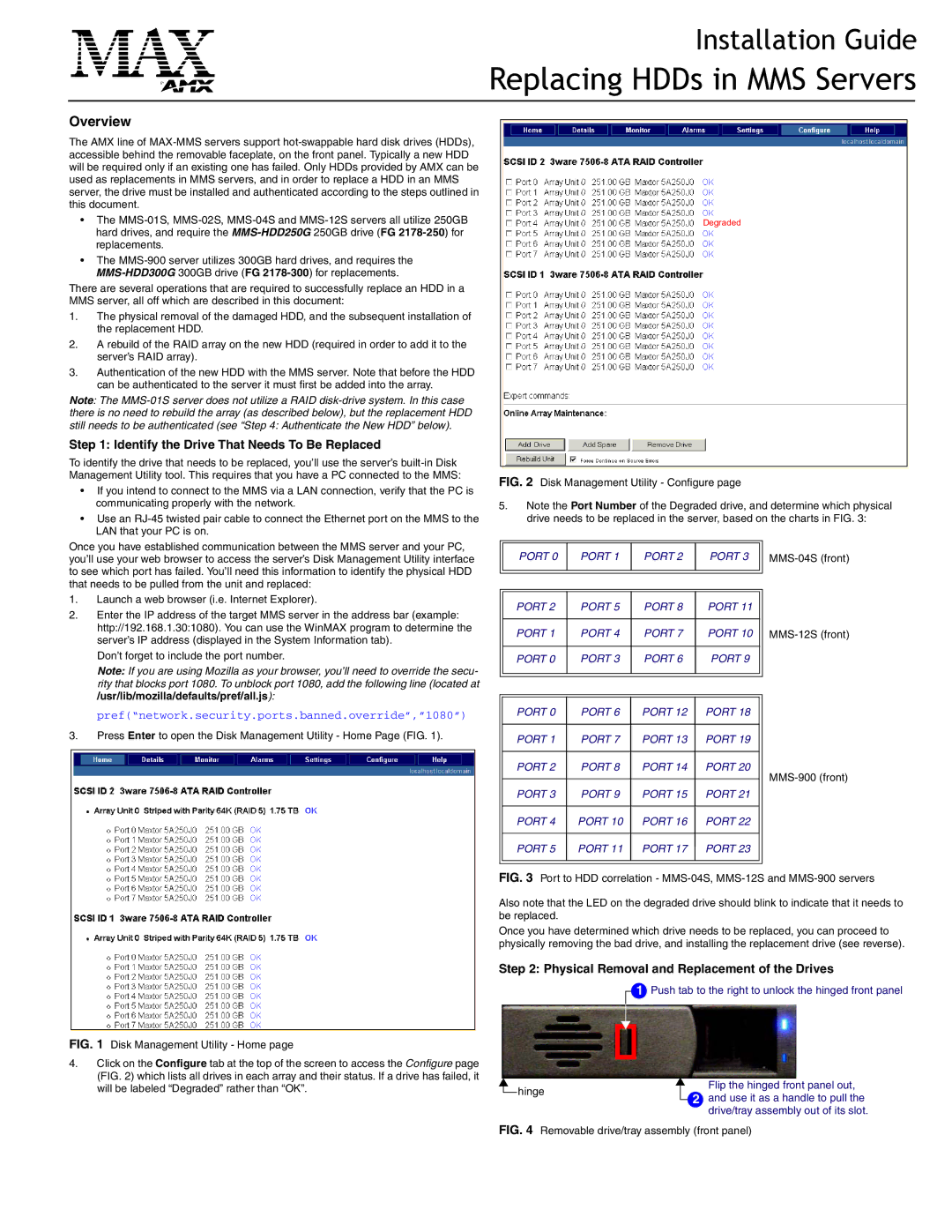
Installation Guide
Replacing HDDs in MMS Servers
Overview
The AMX line of
•The
•The
There are several operations that are required to successfully replace an HDD in a MMS server, all off which are described in this document:
1.The physical removal of the damaged HDD, and the subsequent installation of the replacement HDD.
2.A rebuild of the RAID array on the new HDD (required in order to add it to the server’s RAID array).
3.Authentication of the new HDD with the MMS server. Note that before the HDD can be authenticated to the server it must first be added into the array.
Note: The
Step 1: Identify the Drive That Needs To Be Replaced
To identify the drive that needs to be replaced, you’ll use the server’s
•If you intend to connect to the MMS via a LAN connection, verify that the PC is communicating properly with the network.
•Use an
Degraded
FIG. 2 Disk Management Utility - Configure page
5.Note the Port Number of the Degraded drive, and determine which physical drive needs to be replaced in the server, based on the charts in FIG. 3:
Once you have established communication between the MMS server and your PC, you’ll use your web browser to access the server’s Disk Management Utility interface to see which port has failed. You’ll need this information to identify the physical HDD that needs to be pulled from the unit and replaced:
1.Launch a web browser (i.e. Internet Explorer).
2.Enter the IP address of the target MMS server in the address bar (example: http://192.168.1.30:1080). You can use the WinMAX program to determine the server’s IP address (displayed in the System Information tab).
Don’t forget to include the port number.
Note: If you are using Mozilla as your browser, you’ll need to override the secu- rity that blocks port 1080. To unblock port 1080, add the following line (located at /usr/lib/mozilla/defaults/pref/all.js):
pref(“network.security.ports.banned.override”,”1080”)
3.Press Enter to open the Disk Management Utility - Home Page (FIG. 1).
FIG. 1 Disk Management Utility - Home page
4.Click on the Configure tab at the top of the screen to access the Configure page (FIG. 2) which lists all drives in each array and their status. If a drive has failed, it will be labeled “Degraded” rather than “OK”.
PORT 0 | PORT 1 | PORT 2 | PORT 3 | ||
|
|
|
|
| |
|
|
|
|
| |
|
|
|
|
| |
PORT 2 | PORT 5 | PORT 8 | PORT 11 |
| |
|
|
|
|
| |
PORT 1 | PORT 4 | PORT 7 | PORT 10 | ||
|
|
|
|
| |
PORT 0 | PORT 3 | PORT 6 | PORT 9 |
| |
|
|
|
|
| |
|
|
|
|
| |
|
|
|
|
| |
PORT 0 | PORT 6 | PORT 12 | PORT 18 |
| |
|
|
|
|
| |
PORT 1 | PORT 7 | PORT 13 | PORT 19 |
| |
|
|
|
|
| |
PORT 2 | PORT 8 | PORT 14 | PORT 20 | ||
|
|
|
| ||
PORT 3 | PORT 9 | PORT 15 | PORT 21 | ||
| |||||
|
|
|
|
| |
PORT 4 | PORT 10 | PORT 16 | PORT 22 |
| |
|
|
|
|
| |
PORT 5 | PORT 11 | PORT 17 | PORT 23 |
| |
|
|
|
|
| |
|
|
|
|
|
FIG. 3 Port to HDD correlation - MMS-04S, MMS-12S and MMS-900 servers
Also note that the LED on the degraded drive should blink to indicate that it needs to be replaced.
Once you have determined which drive needs to be replaced, you can proceed to physically removing the bad drive, and installing the replacement drive (see reverse).
Step 2: Physical Removal and Replacement of the Drives
1Push tab to the right to unlock the hinged front panel
hinge |
| 2 | Flip the hinged front panel out, |
| |||
| and use it as a handle to pull the | ||
|
| ||
|
|
| drive/tray assembly out of its slot. |
